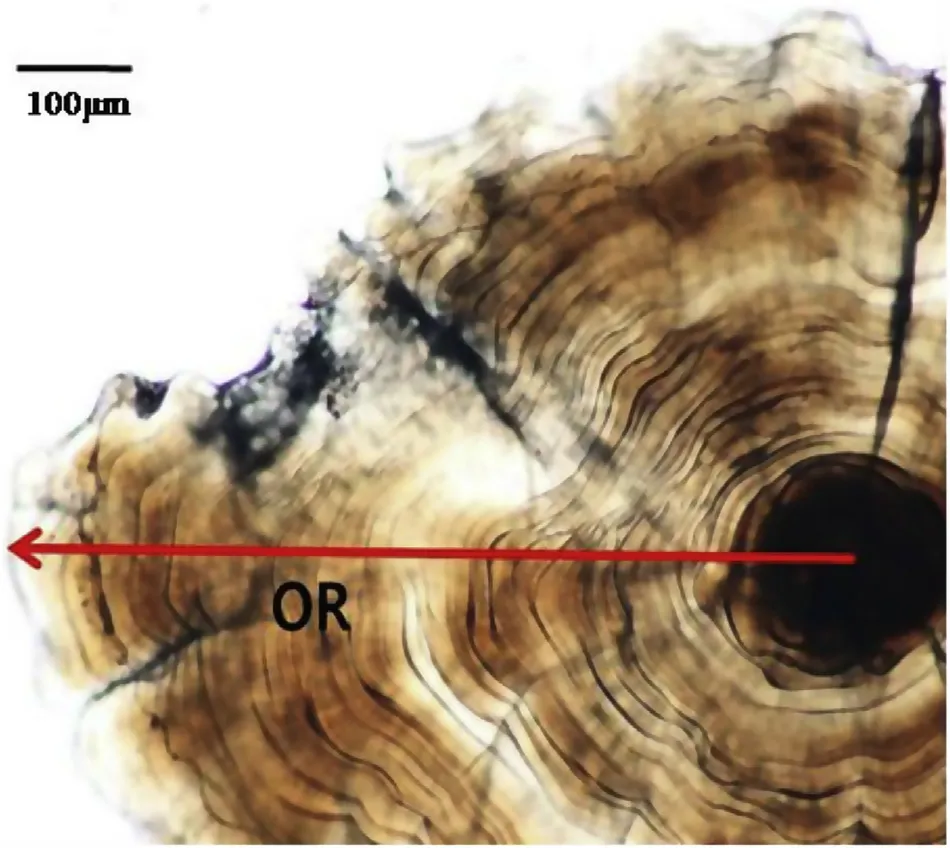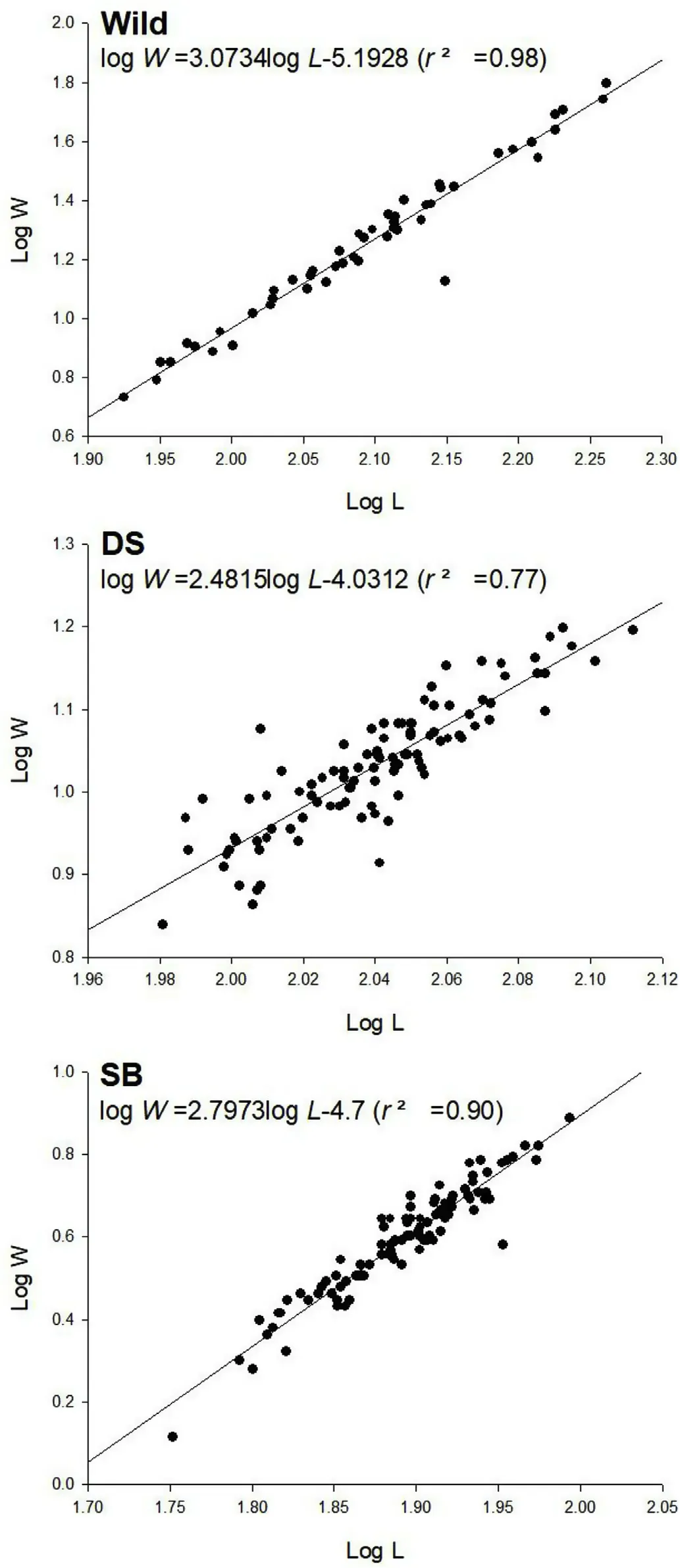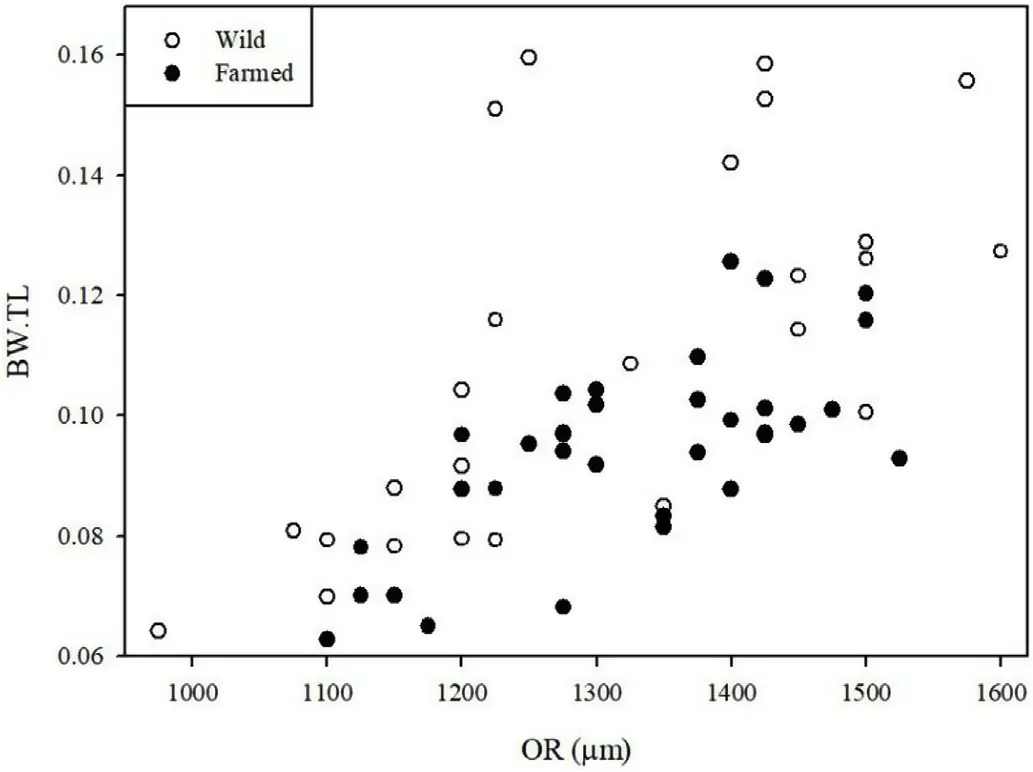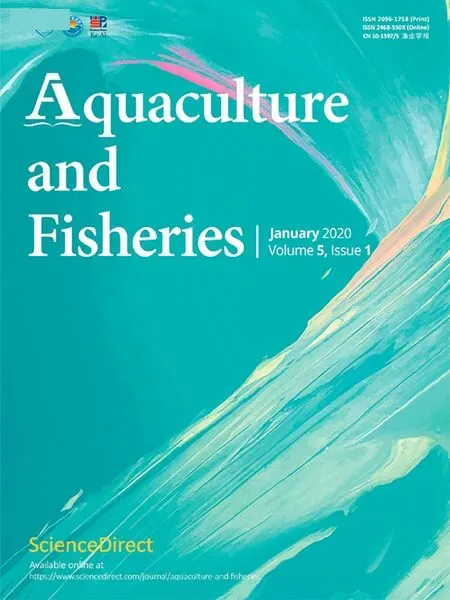Comparison of juvenile growth of wild and hatchery-raised olive flounders Paralichthys olivaceus as examined by otolith microstructure
Juri Yoo,Tae Won Lee,Keun-Hyung Choi
Department of Oceanography and Ocean Environmental Sciences,Chungnam National University,Daejeon,34134,South Korea
Keywords:
ABSTRACT
1.Introduction
Korea's fishery resources have gradually decreased due to overfishing,environmental pollution,coastal development,and other factors.Therefore,coastal fishery production has also been on the decline since the 1990s.In 1986,the production of coastal fisheries was 1,725,820 tons but reduced to 1,000,000 tons in 2018.Accordingly,the need for fisheries and releasing projects for the continued use and management of fishery resources has also increased(Hwang,Lee,Jeong,& Kim,2005;KOSIS,2019).
Fish stocking,or fish planting,which is the practice of raising fish in a hatchery and releasing them into their natural habitat,is a common way to supplement existing natural populations,especially given the dwindling population of fishes in many estuarine and coastal waters(Abelson,Obolski,Pegoniel,&Hadany,2016;Lorenzen,2005;Obolski,Hadany,& Abelson,2016).Fish stocking may not only contribute to increased fishing yields,which can sustain coastal communities,but it can also assist in the buildup of a critical fish biomass for basic ecosystem functions such as grazing on lower trophic organisms and further enhancing the restoration of degraded ecosystems(Hwang et al.,2005;Seo,Paek,& Kim,2010).
Fish stocking is generally conducted via aquaculture to grow adult fishes to supplement market demand or by releasing juveniles into the seawater(Bilton,Alderdice,& Schnute,1982;Collis,Beaty,& Crain,1995;Hwang et al.,2005).Stocking fish is frequently conducted by a government agency at local or federal levels or by institutions or private companies.Despite such potential benefits,there are few studies that compare the growth of aquaculture fish between institutions or with wild juvenile populations.
In the present study,we compared the growth conditions of fish stocks of juvenile olive flounder,Paralichthys olivacues,prepared by two different companies of Korea with natural populations on the west coast of Korea.The fish,belonging to Pleuronectiformes and demersal fish which inhabit the ocean floor,broadly inhabits East Asia(Chyung,1977,p.727;Kim et al.,2005,pp.105-167;NFRDI,2004,p.333;Yamada,Tagwa,Kishida,& Honjo,1986,p.501).Olive flounder is an economically important fish resource in the East Asian countries,especially in South Korea(Jung,Kim,Jeon,& Lee,2001;KNSO,2004;Palaksha,Shin,Kim,& Jung,2008).Recently,South Korea produces nearly 40,000 tons of cultured flounder and more than 50,000 tons in 2009(KOSIS,2019).Both environmental change(e.g.,rising seawater temperature)and more importantly overfishing has caused a significant reduction in fish catches among other important fishes in the region(Hwang et al.,2005;Seo et al.,2010).The release of hatchery-raised fishes is continuing,but the assessment of fish growth at hatchery facilities has not been done yet.

Fig.1.Map of sampling site(Mallipo shallow water)where the wild population of Paralichthys olivaceus was collected in 2012.

Fig.2.Microscopic photograph of a Paralichthys olivaceus otolith.
The otolith is the a calcium carbonate structur responsible for vocalization,negative reception,and equilibrium sensitivity in Teleostei.It is composed of 96% CaCO3,3% organic matter complex,and 1%mineral element and isotopes(Campana,1983;Campana & Neilson,1982).The otolith of fish grows proportionately with the total length of fish,so if the growth rate of wild fish and cultured fish is different from each other,then the otolith growth rate is also assumed to be different(Christopher,Douglas,&Phillip,1993;Moon&Lee,1999).The otolith microstructure of fish has been previously used for measuring the age,growth rate,and life history information of fish(Brothers,1981;Pannella,1980;Rosenberg&Haugen,1982),which otherwise are often difficult to obtain by other means(Campana,1984).Daily incremental production has been verified in the juvenile starry flounder(Campana&Neilson,1982).Past studies have compared the growth rate of other populations by using the microstructure of otolith(Bailey,2013;Sogard&Able,1992).This study sought to compare the growth rate between a wild stock and a hatchery-reared stock of P.olivaceus for potential recruitment.
2.Materials and methods
2.1.Sample collection
A sample of a natural population of P.olivaceus was collected with a beach seine(stretched mesh size 5 mm,height 1.5 m and length 20 m)on the last night of a lunar month in August 2012 at Mallipo on the west coast of Korea(Fig.1).In addition,two sets of cultured juvenile fishes were collected in the same month from two fish farm factories at the DS fish farm and the SB fish farm in West Korea(ChungnamTaean-gun),respectively.Juveniles at each farm were raised until they generally reached 60 mm in total length and then were released into the sea in August 2012 at locations near the fish farms.
2.2.External characterization and otolith preprocessing
The lengths and weights of 50 wild fish,100 fish from the DS fish farm,and 100 fish from the SB fish farm were measured.The otolith analysis,which included all of the 50 wild fishes,was based on the portion that had no intersection of the translucent zone and the opaque zone in the microstructure of the otolith.We selected 30 fishes for otoliths from each fish farm that had no intersection of the translucent zone and the opaque zone in the micro structure of the otolith.Captured juvenile specimens were stored at 4℃ and their lengths were measured in 0.1 mm unit and weights on a digital scale in 0.1-g units.The left sagitte were extracted from each fish(a total of 30 from each population),washed with distilled water to eliminate organic residues and air-dried.They were embedded in polyester resin with a hardener(Buehler,Castolite resin no.20-8120-002 and hardener no.20-8122-002)and mounted on slide glass(Lee & Byun,1996;Lee & Lee,1989).Each otolith was subsequently abraded with a series of sandpapers(400,800,and 1000 grid)until its nucleus was exposed along the sagittal plane,after which it was polished with alumina powder of 1.0-0.3μm using a polishing cloth and washed with distilled water.An optical microscope(100-500×)equipped with ocular micrometer was used to examine the settled otolith microstructure(Moon&Lee,1999).

Fig.3.Total length(L,mm)frequency distribution of Paralichthys olivaceus collected from Mallipo shallow water in August 2012(125.7±24.92,n=50)and those reared in the DS fish farm in 2012(109.9±6.95,n=100)and the SB fish farm in 2013(78.3±7.85,n=100).
2.3.Observation of otolith microstructure and statistical analysis
A concentric circle exists around the nucleus of the P.olivaceus otolith,after which the circle grows a fan-shape with the front-end growing faster than the back-end.We measured the front-end and named it the Otolith Radius(OR)(Fig.2).The age of each fish was estimated by checking each otolith's daily growth increments.We also analyzed the correlation between the total length and length of the OR.We used a least squares regression and analysis of covariance(ANCOVA)to compare the farmed populations with the wild populations to determine the relationships among total length,weight,and age.ANCOVA is used when we have a categorical variable with multiple values(covariates).The effect of the categorical variable is examined by comparing the regression lines for each level of the categorical variable.Normality of errors was checked with Shapiro-Wilk's normality test(P>0.05 for all analyses).Homogeneity of variance was examined with Levene's Test.If the variance of the data were not homogenous,a non-parametric ANCOVA was conducted(Bowman & Azzalini,1997;Bowman,Azzalini,Bowman,& LazyData,2018).
围绕毕业要求和培养目标的达成,建立了“学业指导”“职业规划与就业指导”“心理健康教育”三个体系,具有完善的制度和措施,并能够很好地执行落实,且实施效果显著;学生录取分数高于学校平均分数线;专业就业率高,学生身心健康。

Fig.4.Relationship between total length(L,mm)and body weight(W,g)of Paralichthys olivaceus collected from Mallipo(in shallow water)in 2012,the DS fish farm in 2012,and the SB fish farm plotted on logarithmic axes.Mallipo's linear regression equation was logW=3.0734logL-5.1928(r2=0.98).The DS fish farm's linear regression equation was logW=2.7973logL-4.7(r2=0.90).The SB fishfarm's linear regression equation was:logW=2.4815logL-4.0312(r2=0.77).

Fig.5.Scattered diagram of the otolith radius of Paralichthys olivaceus versus age from Mallipo(in shallow water)(y=0.0739x+9.1703,r2=0.87),the DS fish farm(y=0.0383x+57.3797,r2=0.34),and the SB fish farm(y=0.0515x+25.5282,r2=0.33).

Fig.6.Relationship of juvenile weight/length ratio to otolith length(only those of<1600μm)compared between wild and hatchery-reared juveniles.

Table 1 Analysis of covariance for the relationship of juvenile weight/length ratio to otolith radius(OR,only those of<1600μm)compared between wild and hatchery-reared(i.e.,farmed)juveniles.Otolith radius of wild population was the independent variable,weight/length ratio dependent variable,and the otolith radius of farmed(both DS and SB pooed)was covariates.
All of the statistical analyses were performed with the R package[V.3.3,R Core Team(2013)].
3.Results and discussion
3.1.Length-weight relationship of P.olivaceus
The total length(TL)of the wild-caught fish ranged from 58.8 mm to 182.4 mm,averaging 111.2 mm(mean±SD at 125.7±24.92,Fig.3).Cultured juveniles showed a smaller variation in total length variation compared with those from the fish farms:the fishes from the DS fish farm(n=100)had lengths between 95.7 and 129.4 mm(mean at 109.9±6.95),and those from the SB fish farm(n=100)had lengths between 56.5 and 98.6 mm(mean at 78.3±7.85).The weight varied between 2.1 and 62.5 g for the wild population,1.3-7.7 g for those reared at the SB fish farm,and 6.9-15.8 g for those at the DS fish farm,respectively.
As there were large differences in the mean lengths and weights among the three groups of the fishes(Fig.4),a comparison was made only for the length-weight relationship(i.e.,difference in slope)and not for the intercept(i.e.,initial length or weight of each group of fishes).Given the non-homogeneity of the variance(Leven's Test,F-value>19.11,P<0.001 for both log 10 transformed total length and body weight),a non-parametric analysis of covariance(ANCOVA)was performed(sm.ancova package,Bowman et al.,2018).The results showed no difference in the slope among the three groups of fishes in the length-weight relationship(P=0.24),suggesting that the three groups of fishes grew almost in a similar fashion.
3.2.Otolith microstructure and growth
For most fish species,it is known that daily growth occurs only after hatching(Campana & Neilson,1982;Radtke and Scherer,1982).Both Platichthys stellatus and the Pseudopleuronectes americanus,which are Pleuronectiformes,have proved that daily growth increments were formed at the otolith(Campana & Neilson,1982;Radtke and Scherer 1982).Bailey(2013)used correlation of growth rate indexes(TL/daylength growth,K-body weight growth)for winter flounders,P.tapirine.The otolith of P.olivaceus is oval-shaped,and the growth rate of the front-end grows faster than the back-end.Therefore,the otolith radius of P.olivaceus was marked and started from its nucleus.
The otolith radius was measured from its nucleus to the front-end,which ranged between 775 and 2350μm for the wild flounders,whereas it ranged between 1200 and 1525μm for those raised at the DS fish farm and 875 and 1275μm for the juveniles raised at the SB fish farm,respectively.The number of daily growth increments in the otolith of wild juveniles was 97-272μm(mean±SD,162±36.9).It was 123-174μm(153.1±10.7)for the juveniles from the DS fish farm and 122-167μm(146.4±11.5)for those from the SB fish farm.
The mean age of wild fishes was 162 days,which was estimated from the otolith microstructure daily growth increment.The hatchery fishes from the two factories were slightly younger:the average age from the DS fish farm was 153 days old,while those cultured at the SB fish farm were only 46 days old.The small ranges of fishes rendered the use of the relationship between age and fish length inappropriate for growth estimation.However,they seemed to overlap with each other(i.e.,between the DS fish farm and the SB fish farm)and with the group of fishes caught in wild.
The otolith radius of Paralichthys olivaceus versus age[wild fishes:y=0.0739x+9.1703,r2=0.87);DS fish farm fishes:y=0.0383x+57.3797,r2=0.34;SB fish farm fishes:y=0.0515x+25.5282,r2=0.33,Fig.5].R-square results showed that the wild population had a stronger relationship than cultured fishes between the total length and otolith radius.However,such a relationship could potentially be attributed to the sampling of the wild population(i.e.,the broad range of the sizes caught,Fig.3).Given the wide variation of the fish sizes,we pooled data from the farmed juveniles into one group and compared the juvenile weight/length ratio with wild juveniles(those of only<1600μm in otolith length).The results again showed that there was no significant difference between the growth of the hatchery-raised and wild populations(Fig.6 and Table 1,ANCOVA,P=0.84 and Levene's Test for homogeneity of variance,F-value=2.07,P=0.15).The wild population seemed to have a greater weight/length variability than hatchery reared ones,which possibly reflects the greater variability of the natural seawater environment(e.g.,food availability and mortality).
3.3.Implication for hatchery-raised juveniles
The condition of the early age of fish is crucial for survival and recruitment(Anderson,1988;Bradford,1992;Leggett & Deblois,1994).Although one study showed that the growth rate at an early age differed between wild and reared fish in olive flounders(Min et al.,2010),no such difference in growth was observed in our study(Fig.5).All of the relationships of growth parameters[i.e.,total length-weight(Fig.4),otolith-total length(Fig.5),and juvenile weight/length ratio relative to otolith(Fig.6)]indicated that the growth was similar between the wild and the reared fish.Our results suggest that the fishes grown at farming facilities have a similar probability of being recruited into the wild once they are released compared to wild juveniles.A better understanding of the contribution of hatchery fish to future fishery recruitment would require using the same otolith microchemistry of the core subadult and adult otoliths with the application of statistical models(e.g.,maximum likelihood mixture models[Avigliano,Pisonero,Sánchez,Dománico,& Volpedo,2018]).The traditional technique of mark and recapture of the released fishes can still be applied as well.The persistent presence of dark spots on the blind side of hatchery flounders,even when they were released in early life stage,serves as natural tags and thus can facilitate such research.
 Aquaculture and Fisheries2020年1期
Aquaculture and Fisheries2020年1期
- Aquaculture and Fisheries的其它文章
- Biofloc technology(BFT):Adjusting the levels of digestible protein and digestible energy in diets of Nile tilapia juveniles raised in brackish water
- The effects of on-farm produced feeds on growth,survival,yield and feed cost of juvenile African sharptooth catfish(Clarias gariepinus)
- Identification and histopathological and pathogenicity analysis of Aeromonas salmonicida salmonicida from goldfish(Carassius auratus)in North China
- Identification and modulation of expression of a TNF receptor superfamily member 25 homologue in grass carp(Ctenopharyngodon idella)
- Probiotics in shellfish aquaculture
